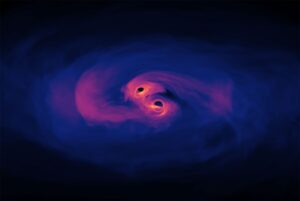New study further narrows the search for elusive pairs of monster black holes

Illustration of a supermassive black hole binary. Credit: NASA’s Goddard Space Flight Center/Scott Noble
Although astrophysicists have never sensed supermassive black hole binary systems, a galaxy-sized detector composed of dead stars is hot on their trail.
In a new Northwestern University-led study, astrophysicists crunched 12.5 years of data from 45 dead stars (called pulsars) to set the best limits yet on the gravitational wave signatures emitted from pairs of monster black holes. Knowing these limits will help astrophysicists constrain the number of binaries existing in the nearby universe, confirm or deny existing binary candidates and, someday, detect gravitational waves from these complex pairs.
In another breakthrough, the study also found that when searching for pairs of supermassive black holes, researchers need to account for the steady hum of background noise made by the symphony of gravitational waves from all the supermassive black hole binaries in the universe.
The study was accepted by The Astrophysical Journal Letters and will be published this summer. A preprint of the manuscript is available here.
“We genuinely think that detection of a supermassive black hole binary through gravitational waves is right around the corner,” said Northwestern’s Caitlin Witt, who led the study. “That would be an important discovery for many scientific fields. It would enable us to perform further experiments like testing gravity to explore whether supermassive black hole binaries evolve the way we think they do, and it will teach us how to look for them in future surveys. We also will be able to look back through cosmic time and trace the history of the universe in which we live.”
Witt is the inaugural CIERA-Adler Postdoctoral Fellow at Northwestern’s Center for Interdisciplinary Exploration and Research in Astrophysics (CIERA) and the Adler Planetarium.
Continue to the full Northwestern News story.

